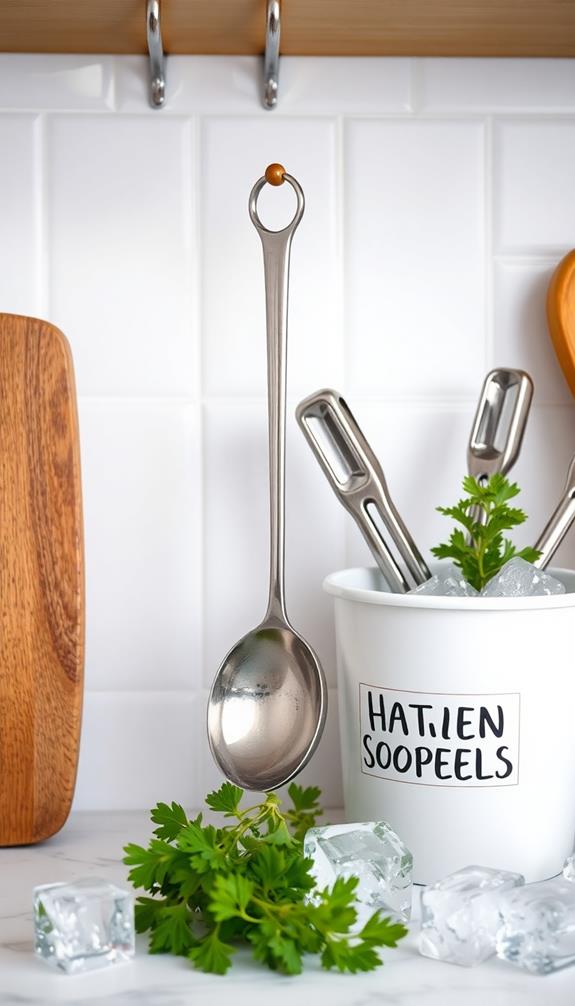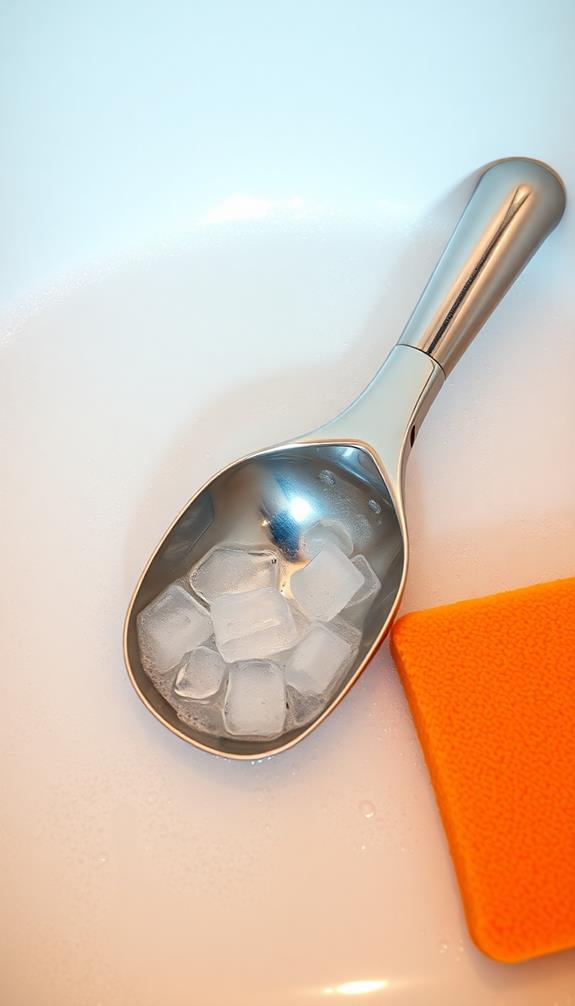To clean and store your metal ice scoop for hygiene, start by washing it daily with warm, soapy water, scrubbing both the handle and scoop. Rinse thoroughly to remove soap residue, then sanitize by soaking in a bleach solution (2 tbsp of bleach per gallon of water) for 10 minutes. Afterward, rinse again to eliminate any bleach. Always air dry the scoop completely before storing it outside the ice bin, ideally using a designated holder to prevent contamination. Avoid returning unused ice to the bin and guarantee proper handling to maintain cleanliness. There's more you can do to enhance hygiene and safety.
Importance of Hygiene in Ice Handling
Maintaining hygiene in ice handling is crucial for food safety. Contaminated ice can harbor harmful bacteria like E. coli and salmonella, leading to foodborne illnesses you definitely want to avoid.
A 2011 EPA study found that 33.3% of ice samples exceeded safe heterotrophic limits, emphasizing the need for proper hygiene in ice handling. To enhance safety, consider using non-toxic cleaning solutions for sanitizing equipment, guaranteeing a cleaner environment for ice storage and handling.
To guarantee the ice you serve is safe, make it a habit to sanitize your ice machine regularly. This prevents contamination right from the source.
Additionally, always store your ice scoop outside of the ice bin. This simple step keeps it clean, preventing any cross-contamination from hands or other utensils.
You should also wash and sanitize your ice scoop daily. Regular cleaning and sanitizing are crucial to maintaining hygiene standards.
And don't forget to wash your hands before handling ice! This best practice reduces the risk of transferring germs and contaminants to the ice.
Steps for Cleaning a Metal Ice Scoop
Cleaning a metal ice scoop is vital for guaranteeing the safety and quality of the ice you serve. Start by cleaning the ice scoop daily with a gentle dish soap and warm water. Be certain to scrub both the handle and the scoop thoroughly to remove any contaminants.
After washing, rinse the scoop under running water to eliminate any soap residue, as this can affect the taste of the ice. To further enhance hygiene, consider using a disinfectant like Seventh Generation, which is eco-friendly and effective against germs.
Next, you'll need to sanitize the ice scoop. Soak it in a bleach solution—use 2 tablespoons of bleach per gallon of water—for at least 10 minutes. Once that's done, rinse the scoop thoroughly with water to wash away any remaining bleach.
After cleaning and sanitizing, allow the scoop to air dry completely. This step is vital, as any moisture left on the scoop can promote bacterial growth.
Best Practices for Ice Scoop Storage

After ensuring your metal ice scoop is thoroughly cleaned and sanitized, proper storage is key to maintaining its hygiene. Always store the ice scoop outside of the ice bin. This prevents contamination from hands or other objects that may come into contact with the ice, similar to how regularly disinfecting surfaces helps reduce harmful bacteria in other areas of your home, such as your bathtub maintaining a clean environment.
If you must keep the scoop near the ice, make sure to keep the handle out while it's stored. This minimizes contact with the ice, further protecting its hygiene.
Consider using a designated holder or hook in your freezer to store the scoop. This keeps it accessible while ensuring it remains sanitary. Avoid placing the scoop inside the ice bin or returning any unused ice back into the bin, as this can lead to cross-contamination.
Regularly wash the scoop in the dishwasher to keep it clean and free from bacteria. By following these best practices for ice scoop storage, you can markedly reduce the risk of contamination and maintain a high standard of hygiene for your ice.
Keeping your ice scoop properly stored is essential for ensuring the safety of the ice you serve.
Recommended Cleaning Products
When it comes to cleaning your metal ice scoop, choosing the right products is essential.
Opting for eco-friendly cleaning options not only guarantees the safety of your scoop for food use but also minimizes environmental impact.
You'll want effective sanitizing agents that eliminate bacteria, as well as eco-friendly solutions that keep your scoop safe for food use.
Let's explore some recommended options that meet these needs.
Effective Sanitizing Agents
Maintaining a metal ice scoop's cleanliness is vital for food safety, and using the right sanitizing agents makes all the difference. To guarantee your stainless steel ice scoop remains hygienic, consider using products specifically designed for this purpose.
Predator is an excellent no-rinse sanitizer that effectively eliminates a wide range of bacteria, making it perfect for sanitizing your ice scoop after thorough cleaning.
For regular maintenance, Clean Ice is a non-fuming cleaner that removes lime scale and hard water deposits without harmful fumes, providing a thorough clean.
Another option is F-2002, an acid replacement cleaner that targets hard water scale and mildew, important for maintaining hygiene. If you're dealing with nickel-plated surfaces, Shiny Nickel is specialized for removing scale and keeping your equipment contaminant-free.
Always verify that the cleaning products you choose are USDA approved, particularly when sanitizing your ice machine or any tools that come into contact with food or ice.
Eco-Friendly Cleaning Solutions
Choosing eco-friendly cleaning solutions for your metal ice scoop not only promotes hygiene but also helps protect the environment.
When you're in the food service industry, maintaining clean ice and ice-safe equipment is essential.
Here are four recommended eco-friendly products to keep your scoop in top shape:
- Clean Ice: This non-fuming cleaner effectively eliminates lime scale and hard water deposits, ensuring your metal ice scoop remains free of harmful buildup.
- Predator: An effective no-rinse sanitizer, Predator targets various bacteria, making it perfect for sanitizing metal ice scoops without leaving any harmful residues.
- Shiny Nickel: This product helps remove scale from stainless steel surfaces, maintaining the aesthetic and hygienic quality of your metal ice scoop.
- F-2002: As an acid replacement cleaner, F-2002 tackles hard water scale and mildew, promoting a cleaner and safer ice retrieval process.
Daily Maintenance Tips

Cleaning your metal ice scoop daily helps guarantee it stays hygienic and free from contamination. Start by using a gentle wash cloth and mild detergent to wipe away any ice residue. This simple cleaning step is essential for maintaining your ice bin's cleanliness, as well as preventing the buildup of harmful bacteria on kitchen surfaces, which can be addressed with effective disinfectants like Clorox Free & Clear Multi-Surface Spray Cleaner.
After washing, rinse the scoop thoroughly with clean water to eliminate any soap residue that could affect ice quality.
Once rinsed, allow the ice scoop to air dry completely. This prevents moisture buildup, which can encourage bacterial growth—something you definitely want to avoid.
To further promote hygiene, store the metal ice scoop outside of the ice bin. Consider using a designated holder or hook to keep it separate from the ice, minimizing the risk of contamination.
Common Mistakes to Avoid
When it comes to cleaning and storing your metal ice scoop, there are some common mistakes you should steer clear of.
Don't store the scoop in the ice bin, as that can lead to contamination.
Also, make sure to clean it regularly and avoid using contaminated scoops to maintain hygiene.
Improper Storage Practices
Storing your metal ice scoop improperly can lead to serious hygiene issues.
It's important to be mindful of how you store your scoop to avoid contaminated ice and guarantee safe handling. Here are some common mistakes to avoid:
- Storing in the Ice Bin: Never keep your ice scoop inside the ice bin. This can lead to contamination from hands or surfaces touching the ice.
- Handle Submerged in Ice: Don't place the scoop with its handle in the ice. This traps bacteria and debris, compromising hygiene.
- Neglecting Designated Holders: Always use a designated holder or hang the scoop outside the ice bin. This keeps it clean and easily accessible for use.
- Choosing the Wrong Material: Avoid aluminum scoops, as they can oxidize and leave residue. Opt for stainless steel scoops for better hygiene and durability.
Neglecting Regular Cleaning
Neglecting to clean your metal ice scoop regularly can lead to serious hygiene issues. When you skip daily cleaning, harmful bacteria like E. coli and salmonella can build up, especially if your ice scoop is stored in the ice bin. This environment fosters cross-contamination, increasing the risk of spreading pathogens. To maintain proper hygiene, always wash your ice scoop thoroughly after each use.
Moreover, if you don't guarantee your scoop is completely dry before storage, you're inviting bacterial growth. Moisture creates the perfect breeding ground for microorganisms.
It's also vital to avoid using the scoop for anything other than ice retrieval. Using it to measure other ingredients can greatly raise the risk of contamination.
Lastly, be mindful of how you store your ice scoop. Ignoring proper storage practices, like placing the scoop with the handle out in the ice or on a designated holder, can lead to it being touched by contaminated hands or surfaces.
Using Contaminated Scoops
Many people unknowingly use contaminated scoops, which can lead to serious hygiene issues. To guarantee you're using your ice scoop correctly and maintaining cleanliness, avoid these common mistakes:
- Storing in the Ice Bin: Always store your metal ice scoop outside the ice bin. This prevents direct contact with the ice, reducing the risk of contamination.
- Using Improper Tools: Never use your hands, glasses, or other kitchen utensils to retrieve ice. This practice introduces bacteria and contaminants, compromising hygiene.
- Neglecting Daily Cleaning: Clean your ice scoop daily with warm, soapy water or in a dishwasher. Regular cleaning helps keep the scoop sanitary and free from harmful contaminants.
- Reusing After Dispensing: Avoid placing the scoop back in the ice bin after use. Instead, use it solely for dispensing ice to maintain ideal hygiene.
Additionally, regularly inspect your ice scoop for signs of wear or damage. A compromised scoop can harbor bacteria in cracks or scratches, putting you and your guests at risk.
Prioritizing hygiene with your ice scoop sets a standard for cleanliness.
Conclusion
Keeping your metal ice scoop clean and properly stored is vital for maintaining hygiene, especially since studies show that ice can harbor more bacteria than tap water. By following the cleaning steps and best practices outlined, you can guarantee your scoop stays in top shape. Regular maintenance not only protects your health but also enhances the quality of your drinks. Don't overlook this simple yet essential tool—your guests will thank you for it!